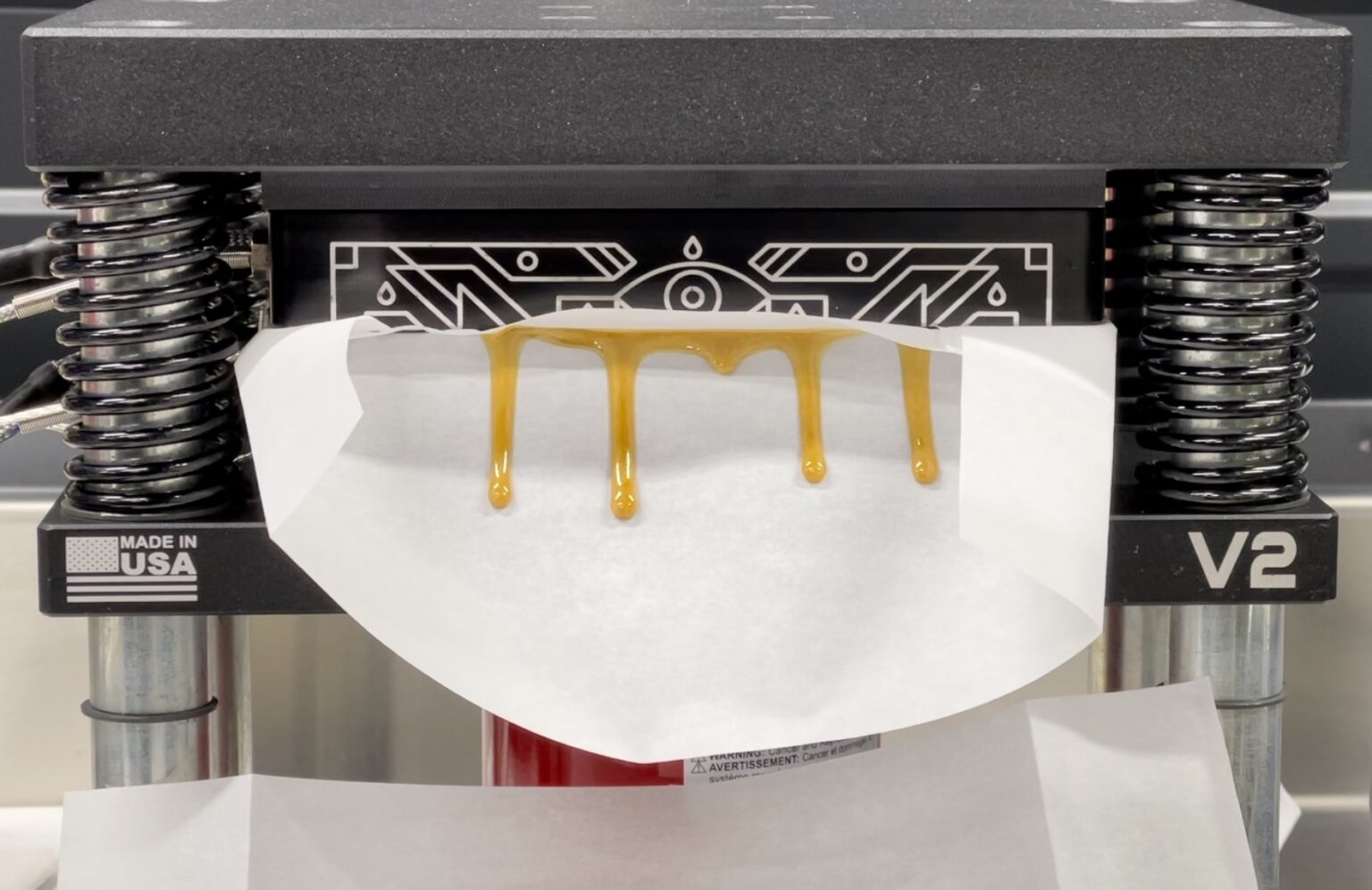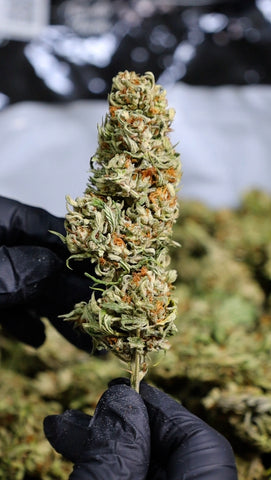Introduction to Solventless Hash Rosin

What Are the Differences Between the Various Types of Hash & Rosin?
While hash and rosin are broad terms, there are multiple methods of producing hash and rosin that each lead to a distinct solvent-less cannabis concentrate. In this article, I will go into detail about the distinctions between the various methods of extraction and final forms of these historical, and ground-breaking concentrates:
What is hash?
Hash, or hashish, is a concentrated form of cannabis produced by isolating and combining the resin glands (trichomes) from the female cannabis plant. Hash can range in purity and color based on the isolation/extraction process and amount of non-trichome plant material such as stalks, stigmas (orange hairs) and fine pieces of chlorophyll-containing leaves. [Figure 2] shows a collection of mainly trichome heads with minimal contaminant.

Hash is typically made in 3 ways: hand-rubbing, dry-sifting, or ice water extraction (bubble hash).
Hand-rubbed hash, or Charas, is the oldest form of cannabis concentrate and is made by rubbing freshly harvested flowers between the hands, allowing resin to build up on the palms and fingers and alternating between removing broken plant material and collecting the hash into a single mass. We know this to be the oldest cannabis concentrate because it is inevitable that resin will be collected on the hands while harvesting seeds or fiber, and we know that cannabis fiber use dates back thousands of years. Therefore, the psychoactive effects of cannabis must have been discovered around the same time or before its use as fiber. Although unique and historical, this is a traditional, time-consuming, non-sanitary process that is not commonly utilized by recreational or medical companies. It is still practiced by countries at the feet of the Himalayas though, such as Bhutan, Nepal and Northern India. Growers in Western countries are more likely to dry-sift or extract with ice water so we will focus on those methods in this post.

Dry-sift [Fig. 3], also commonly referred to as “kief” is made by meticulously bouncing and moving dried cannabis buds or sugar leaves across screens (like silk screens used for screen printing.) Agitation and friction help separate the delicate trichome glands and stalks from the flower. The tightly woven screens allow only fine particles to pass through, leaving plant material on top, and after repeated sifting and collecting of this powder-like kief through a series of screens with increasingly finer micron ratings, it’s ready to enjoy or be pressed into dry-sift rosin. The idea is that plant matter stays on the top screen, large heads and stalks fall through to the second screen, then the second screen is gently sifted to allow the stalks to fall through while the heads remain on top of the second screen. This process can be customized to catch both larger and smaller heads by changing the screen micron ratings. It’s also possible to use kief caught under trimming trays with impregnated mesh screens or kief from automated trimming machines, although the machine blades often break plant matter up to the same size as trichomes and this can only be remediated by static tech or separation by density. Which are both conversations for another blog post.

Ice Water Extraction (IWE) is also known as ‘Bubble Hash’ [Fig. 4]. There are two types of IWE: Dried/Cured Flower IWE & Live/Whole Plant Fresh Frozen (WPFF) IWE. The concept behind making both types of hash is the same: rehydrating the plant material by soaking and suspending in ice water, makes the trichomes cold and brittle and able to easily snap off the stalks after slight agitation. Agitation like spinning in a machine, hand-mixing w/ paddle/whisk, sonication, etc. Contact with the mixing paddle/impeller is not what causes the trichomes to fall off, which is actually damaging to the material, but it is rather friction caused by the movement of cold water that detaches the heads. It’s not a 100% parallel comparison: but it can be thought of almost like centrifugal force – the buds spin and the trichomes fall off.
This process is often done by hand in large food-grade plastic bins/buckets, or in modified, plastic clothes-washing machines (which hold a large amount of bacteria if not properly modified) and now, for the professional SHO extractor: IWE process-specific stainless steel washers/agitators with thermal jackets, such as The Osprey.

The Osprey is a 75 gal/280L washer from Lowtemp Industries. The Osprey can handle up to 21,000g/46lbs of Fresh Frozen Flower or 4,600g/10lbs of Dried Flower at a time and with programmable memory: hash makers can save and record washing parameters as ‘Recipes’ and duplicate results effectively from batch to batch. With sanitary, stainless steel welds, no crevices to catch hash or bacteria, sanitary Triclamp/quick clamp valves & fittings and an easily removable impeller, the Osprey is simple to clean and sanitize and meets Food Safety requirements. The anodized aluminum impeller is food-grade and does not chop up or blend material, rather it gently but thoroughly mixes the material, washing the trichome heads off their stalks. This imitates the toroidal flow generated by hand washing and allows all the plant matter to turn, rotate and come into contact with cold water. [FAQs about Osprey] [ROI info for LowTemp Osprey Washer]
Once the plant material has been thoroughly agitated, the trichomes must be separated from the water and collected. The ice water hash slurry is filtered through a set of screens or ‘bubble bags’ with increasingly smaller micron ratings and each bag is either kept separate to be dried then sold as micron-range-specific hash (i.e. 70u-120u) [Fig. 4] , or combined as a ‘mixed-micron’ product (25u/45u-149u). Low Temp Industries will be releasing sieving columns very soon, which will be available as an attachment to the Nest Tank in Mid 2021. They will be backwards compatible on all Nest Tanks. The goal with these is to eliminate the headache of washing bubble bags, and the finesse required to collect hash off floppy nylon screens. Simply drain all of the wash into a column that sieves out different microns, collect, dry and consume, press or infuse into carrier of your choice.

After washing and before use or pressing into rosin, the wet IWE/bubble hash must be dried. This can be accomplished by freezing and grating or sieving the wet hash onto parchment paper & air-drying [Fig. 5] over the period of 4-7 days with regular agitation. Alternatively, with some investment, one can use a piece of equipment called a freeze-dryer or lyophilizer [Medium Harvest Right Freeze-Dryer] to remove the water content in ~24 hours [Fig. 6]. Once dried, this hash can be enjoyed on a bowl/joint, dabbed if full-melt or pressed into rosin. The benefits of freeze-drying are many and include increased terpene retention, lighter color due to trichome stability, dramatically shorter timeline than air-drying, less worker hours needed, less of a workspace footprint and full confidence that no water remains, and no mold growth will occur. (Never press wet hash into rosin, as the water will steam, interact with the terpenes and smell like a wet dog. It will ruin your rosin, potentially cause mold growth in a sealed jar and at minimum, will dramatically decrease the shelf life of your rosin.)

What is Rosin?
Rosin, is a dab-able cannabis concentrate produced by applying heat and pressure to hash or cannabis flowers and collecting the extruded resin/oil. This mechanical technique is performed with a specialized tool called a ‘rosin press’ [LowTemp V2 Press] consisting of two opposing, temperature-controlled and heated metal plates that are forced together with a hydraulic, pneumatic, electric or hand-powered pump. The starting material such as flower or hash is fit into a filter such as a ‘micron rosin bag‘, sandwiched between a folded piece of parchment paper [Black Label Parchment via LowTemp] and placed between the plates while heat and pressure is applied. The rosin pressing process crushes the cannabis trichomes and causes the waxy membrane to rupture, allowing compounds such as cannabinoids and terpenes to escape onto the parchment paper [Fig. 7], which can then be easily collected and consumed as a dab-able product. [Fig. 8]


Rosin, also known as SHO (Solvent-less Hash Oil) [Fig. 8] is desirable to consumers and producers alike, due to the simple fact that no external solvents are used and equipment investment is modest compared to solvent-based extraction techniques like BHO (Butane Honey Oil). The safety profile of Hash Making and Rosin Pressing is also exponentially higher than hydrocarbon extraction due to the lack of explosive solvents. There is no need for a C1D1 Explosion-proof laboratory, although when it comes to Ice Water Extraction there is need for a controlled temperature environment that can get to 50°F. A window AC unit can be modified with a CoolBot temperature controller to get your room down to temp. Rosin can be made in a variety of ways, from pressing dried flower to dry-sifting cured buds to make hash to press, as well as extracting both dried & fresh frozen flower via ice water isolation to make “Bubble Hash” to press into rosin. The accessibility offered by the multitude of starting materials that can be pressed, allows even the home processor and medical patient to make their own solventless concentrates with a rosin press [Fig. 7].


Rosin comes in 3 typical forms: Flower Rosin, Dried/Cured Flower IWE/Bubble Hash Rosin and Live Bubble Hash Rosin/WPFF Rosin.
Flower Rosin [Fig. 10] is the simplest of all rosin forms and is easily made, even at home, by pressing dried buds in between parchment paper with a rosin press. Filtration is not 100% necessary, but [LowTemp Industries 220u Stitchless Rosin Pouches] simplify and speed up the process, preventing major contamination and allowing for higher weights of starting material. Buds can be stuffed into the pouch by hand, or pre-pressed in molds [Fig. 9] for faster workflow. Flower rosin is often sappier with a darker color due to higher pressing temps and introduction of anthocyanins and chlorophyll via plant material, which may contribute to ‘the entourage effect’. [Fig. 10] Flower rosin is not easily post-processed into products like Jam, Diamonds, or carts but can be used to re-press into THCa Isolate [Fig. 11] or infused into carrier oils for edibles.

Dried/Cured Flower IWE Rosin is made by pressing the resulting hash from an ice water extraction/isolation that uses dried/cured cannabis flowers [Fig. 12] as the starting material. This process requires the trimmers and extractor to be gentle with the starting material, as the trichomes are easily separated from the stalks, and the plant material is brittle enough to break into pieces as small as the trichomes. High quality rosin can be made from dried flowers if harvested and stored properly, but dried flower IWE yields suffer as plant matter contracts during drying and trichomes become physically difficult to access and isolate.

Surface area is of much importance when considering which cultivar to wash. Dense buds are less ideal than genetically fox-tailed or borderline “larfy” buds. Intense light increases resin production as well as the density of buds, which is another reason pheno-hunting is so important. Different cultivars have different uses: Some flower is best smoked, some best blasted, some best pressed and some best washed. Cannabis is a versatile plant, and it is up to the extraction technician to determine which pheno will perform best for their custom isolation or extraction processes. If breaking up larger buds before extraction, take care to hold by the stem and use trimming scissors to snip the bud sites off the stem opposed to crushing/grinding or cross-cutting, as trichomes are easily crushed and chlorophyll easily released from broken plant matter. Buds the size of a bowl/tip of thumb is ideal for maximum yield in washing. The color can also be affected if using aged starting material, as trichome heads turn amber as they age and the THCa degrades to THC and then CBN (Which can be desirable if aiming for a more sedative dabbing experience.) Terpene content can be slightly lower than Live Rosin, but also has a longer shelf life due to its cured starting material origin. This rosin can be post-processed into products like Budder, Badder, Vape Carts, and THCa Isolate [Fig. 11] but does not typically perform the best for cold-cure or Jam/sauce/diamonds/jar-tech unless it has a high terpene content. Makes a sugary sauce, which some hash makers prefer. [Fig. 13]

Live Rosin, or Whole Plant Fresh Frozen – WPFF (A misnomer as the roots, stems and fan leaves are not washed, only the buds and sugar leaves) Is one of highest grades of rosin as it requires a dedicated crop, grown exclusively for resin production, in tandem with a timed and extremely attentive harvesting process where the plants are handled gently and frozen rapidly after chopping down. [Fig. 14] I will go into detail about the proper harvest procedure in another blog post, but it is important to not put too much fresh frozen into each bag, as well as ensuring minimal vacuum is applied to the freezer bags. Take care to not crush the trichomes by overhandling the bag or stacking bags atop each other. [Fig. 15] shows a proper example of Fresh Frozen Storage. Standing bags vertically inside a barrel prevents crushing, guards against heat cycling and allows for stacking of multiple barrels, maximizing freezer space.


Extracting “live” plants (even though they are technically “freshly dead” once cut) leads to a higher % yield of flower > hash as well as hash > rosin %, higher terpene content and an easier-to-handle rosin, also a more translucent/lighter color due to trichome heads being younger (less cloudy or amber due to age.) [Fig. 16 & +17] Due to its higher terpene content, live rosin is the most versatile of all rosin forms when it comes to post-processing into various products like cold-cure, sauce/jar tech, vape carts or simple rosin coins. It should also be mentioned that Live Rosin has a shorter shelf life than other SHO forms, as it shows the most degradation over time when not stored in a cold environment. It is imperative for hash-makers to keep their products cold, at all times, when not actively pressing starting material into rosin. When it comes to Ice Water Extraction and handling the IWE hash, there is need for a controlled temperature environment that can get down to 50°F max. A window AC unit can be modified with a CoolBot temperature controller to get your room down to temp.

A Final Thought and New Form of Hash & Rosin
Among the newest market trends in the Solventless community, is the experimentation of breeding and extracting Hemp and High-CBD/Low-THC/Rare Cannabinoid cultivars. The resulting products are known as Hemp Hash and CBD Rosin/Hemp Rosin and can contain a broad range of cannabinoids like CBD, CBG, CBC, CBN, THCv and their associated acidic forms. If the final product tests at <0.3% THC, it is considered legal across all 50 US States and could be a massive subset of the Hash Community. The biggest issues facing Hemp Hash Makers is the lack of quality genetics that produce high levels of resin and desirable terpenes without also containing levels of THC exceeding 0.3%. There is significant research and development being performed by many breeders and extractors across the globe and the field is advancing rapidly. Hemp Hash and CBD Rosin often have a sappier consistency as well as a darker color due to mainly being grown outdoors, but per usual with hash-making: quality is dependent on the starting material: Fire in, fire out.



